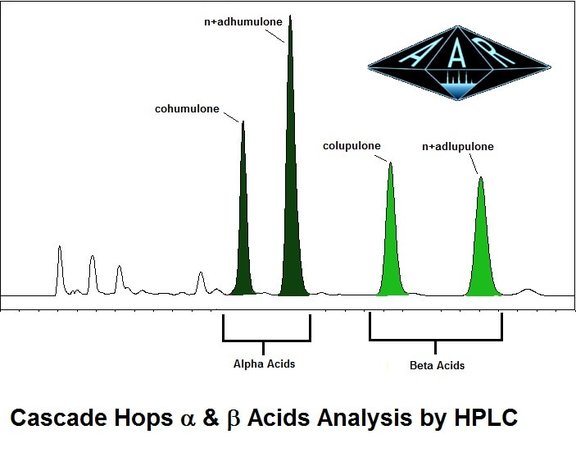|
There is a ton of information out there about alpha and beta acids with the current craft IPA boom. Plant suppliers, producers and brewers need to characterize their products to brew great beer and achieve effective marketing. I see many references to % cohumulone and % colupulone, and hope to clearly and concisely define what these numbers refer to, and where they come from. The % cohumulone (an alpha acid) and % colupulone (a beta acid) numbers can only be obtained but analyzing hops by HPLC (High Performance Liquid Chromatography). The figure above is the output from the ASBC International Method, we see cohumulone (an alpha acid) and colupulone (a beta acid) identified. When someone indicates they have 4% Alpha Acids (with 25% cohumulone), they are referring to the numbers obtained from this method. Let's break it down.....
So on a weight basis, (% or g/100g(same thing)) the hops has a total of 4% or 4grams per 100g of hops. This value is all the alpha acids added together. Cohumulone is analyzed and we find the hops contains 1% cohumulone. So, we describe the amount of cohumulone to be 25% relative to the total. 1/4=.25 x100 = 25% These values should be more clearly defined as (cohumulone - 25% of the Total Alpha Acids) Same exact process for the calculation of colupulone as it relates to the total amount of beta acids. Who cares? and Why? Well, there are many advantages to characterizing your products or ingredients in this way. First, the realtive amounts of colupulone and cohumulone can be a strong indicator of what variety being analyzed, grown, or used in brew, just by simply comparing the results to variety catalogs. In addition, dry hopping and the aroma associated has put a keen focus on the role of beta acids in the brewing process (which until recently, has been diminished). So, more details here about the hops helps in fine tuning. Also, this information can better define the total amounts to be added based on seasonal variability. Lastly, I have found this method procedure is more rugged and accurate than the more widely used spectrophotometric assay (we do this too). So, get more bang for your buck, know your product, sell more of it, and brew a better beer. Thanks, ZL
1 Comment
Your comment will be posted after it is approved.
Leave a Reply. |
AuthorZach Lilla, Lead Chemist at AAR has over 17 years of analytical chemistry experiece focused in the areas of Food, Dietary Supplements, Beer, Wine, Hops, and Distillate Analysis. Archives
August 2022
Categories |
Don't Like the Shopping Cart?
|


 RSS Feed
RSS Feed



